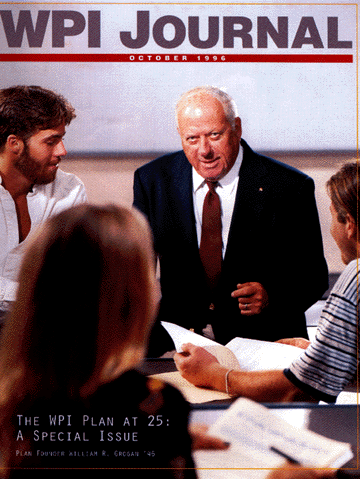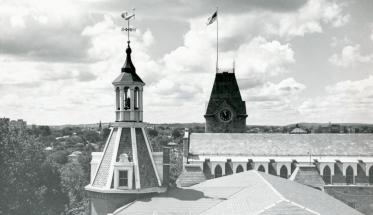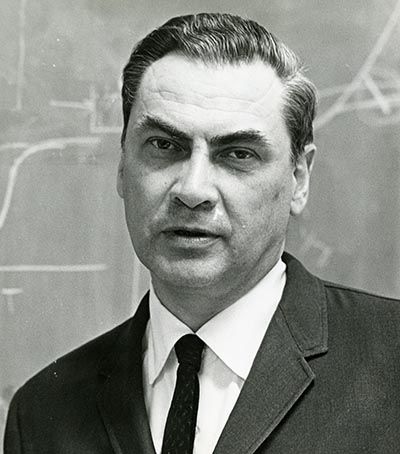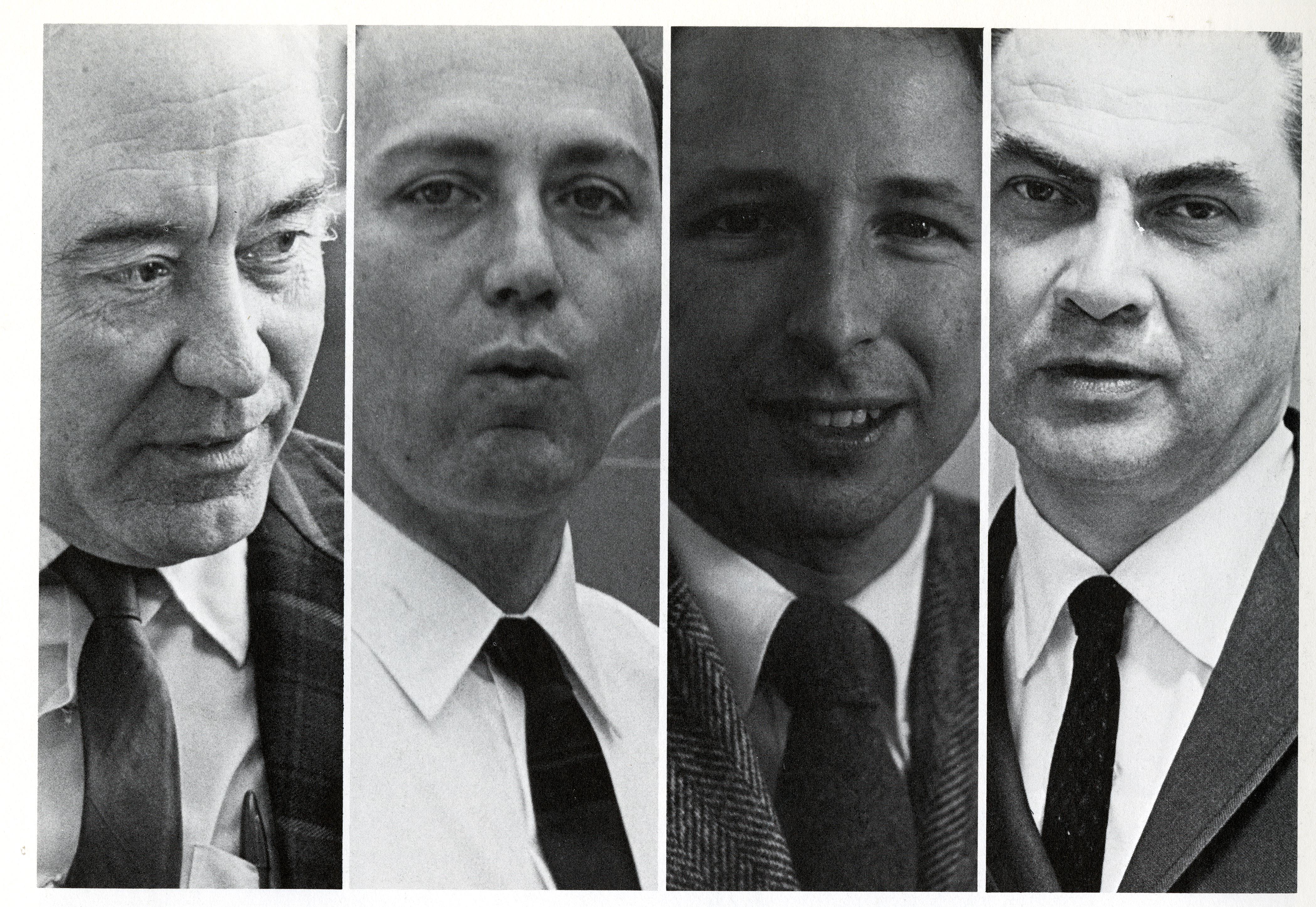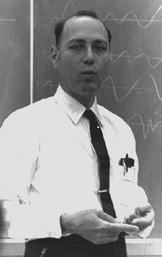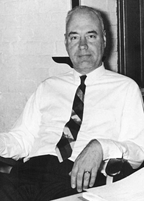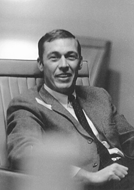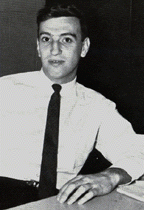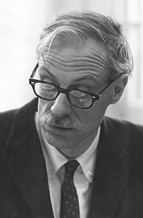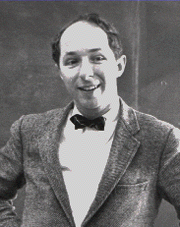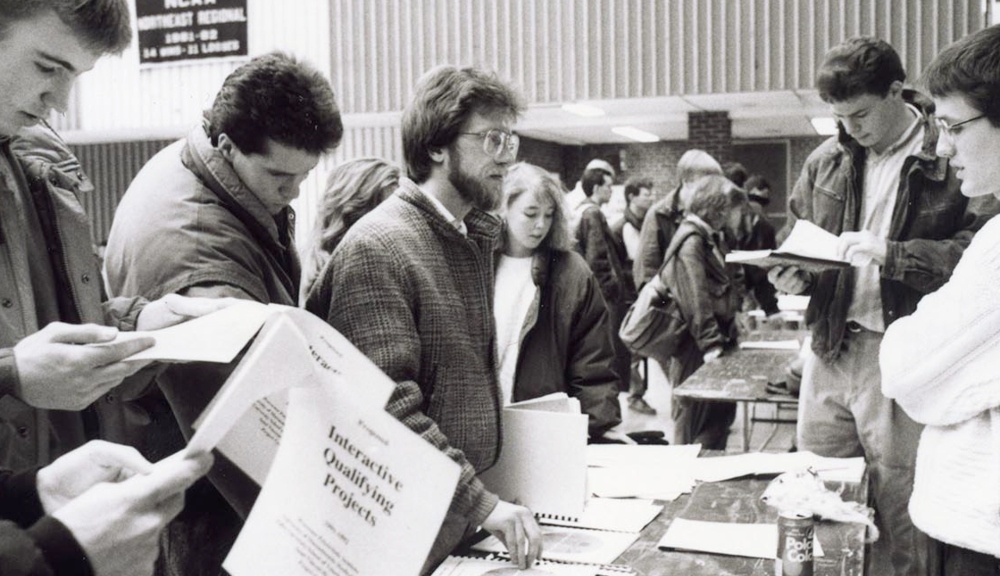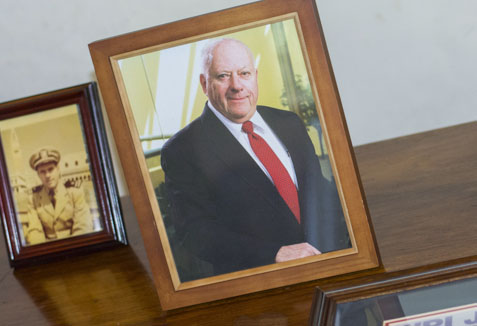"What we've got here is a failure to communicate." -- From Cool Hand Luke, 1967
As one looks back from the perspective of the 1990s, it is hard to imagine how different a place WPI was in the 1960s. For students, the college bore an uncomfortably close resemblance to the high schools they thought they had left behind. WPI seemed reluctant to believe that students could make decisions for themselves, so it gave them few to make. In a typical four-year curriculum, most undergraduates had only two electives. Class attendance was mandatory. Saturday mornings were spent in classes, or in drills for ROTC, which was required of all students. Women guests (there were not yet female students at WPI) were prohibited from residence hall rooms without supervision.
For the faculty, WPI was a warm and supportive community, a small college where everyone knew everyone else and everyone's problems. It was a place where the faculty harbored intense feelings of loyalty and concern for the school where many had earned their academic degrees. And though there was no tenure system, there was an unspoken guarantee of job security.

But WPI was also a place where the power over virtually everything -- including the curriculum -- resided in the hands of a very few senior administrators and department heads. There was no faculty governance system. The agenda for the (quite rare) faculty meetings was drawn up by the Executive Committee of the faculty -- the heads of the academic departments -- and consisted largely of announcements of decisions that had already been made behind closed doors.
It was within this structure that President Storke set out to create change. In late 1963, he outlined a 10-year plan for WPI that encompassed major campus improvements (including a new field house and a modern library) that he and the trustees believed were needed to move the college forward. The plan became the basis for the Centennial Fund, a $15 million capital campaign that culminated in 1965, WPI's centennial year. "The next two years or three years will help shape Tech's destiny for many years," he said in a Nov. 2, 1963, address to alumni. "They will provide each of us an opportunity to participate in a program that will give to our heirs the kind of institution we inherited from our predecessors and to the generations of future students the kind of education needed for tomorrow's world."
He called on the department heads to help define that new kind of education, but they seemed resistant. That December, Storke and Dean Lawrence "Cookie" Price asked the department heads to join them for a retreat at a hotel in nearby Sturbridge to help draft a long-range educational plan to accompany the facilities plan Storke had already developed. By one report, Storke became so frustrated by the department heads' lack of ideas that, early one morning, he summoned them from their rooms and dismissed them without breakfast.
"There are going to be times when we can't wait for somebody. Now, you're either on the bus or off the bus."
-- Ken Kesey, 1968 (quoted by Tom Wolfe in The Electric Kool-Aid Acid Test)
Despite the reluctance of department heads to alter what they believed to be a perfectly workable academic program, Storke knew change was inevitable. He could not help but be aware that students were unhappy. Increasingly, they were voicing their displeasure in the pages of Tech News. Required courses, Saturday classes, mandatory ROTC, the lack of parietal hours in the dorms -- all came under fire as students began to demand more freedom and more responsibility.
And among the faculty were a growing cadre of younger instructors (many with degrees from other institutions) who were eager to break out of the mold. In their own classes, they began to experiment. They included William Shipman, a professor of chemical engineering who came to WPI in 1958. Widely recognized for his award-winning, corporate-sponsored work on combustion and jet propulsion, he was among a small group of faculty then with an active research program. "WPI had many bright and eager students who were looking for something new and exciting to do," Shipman says. "I suggested what those 'somethings' might be, and they did the rest."
Shipman threw away the standard "cookbook" approach to teaching lab courses. Instead, he gave students open-ended problems to solve. "Rather than giving them an experiment on distillation, for example, I asked them to find a way to extract iodine from kelp," he says. "If distillation was required, they would learn about distillation. How they accomplished the assignment was up to them. The enthusiasm in those labs was exciting."
In mechanical engineering, Jack Boyd, who arrived in 1966, was acutely aware of the failing of his own undergraduate education at Ohio State, which had filled him full of facts and equations but left him feeling uncertain about how to use them. He structured his courses at WPI around projects that helped students look beyond the equations to develop "functional literacy."
Over in electrical engineering, Grogan, who kept in touch with the corporate world by consulting for General Electric, Bell Labs and the Navy's Missile Systems Division, had been incorporating project work in his course in engineering economics. To add an element of realism to the course, he had students take on the role of professional consultants, completing small projects sponsored by corporations.
Grogan was one of a group of young faculty in electrical engineering who, starting in the late 1950s, met regularly -- often on Friday afternoons in nearby Bigelow's Tavern -- to talk about education and their (at least for WPI) radical notions about teaching and learning. In time, this group, which eventually included Owen Kennedy '44, Romeo Moruzzi, Harit Majmudar, Wilhelm Eggimann, Donald Eteson '48 and George Stannard '43, welcomed fellow travelers from other departments, including Boyd, Charles Heventhal, a professor of English who arrived in 1963, and Stephen Weininger, a chemistry professor who came on board in 1965.
Grogan also chaired a study committee in the Electrical Engineering Department that in the spring of 1966 presented a revised and somewhat liberated electrical engineering curriculum to the faculty Executive Committee. The report, which was approved, generated some discussion at a faculty meeting, something that had never happened before.
Despite this step forward, Grogan saw little prospect for campus wide change. But later that year Storke decided to appoint a faculty-based Curriculum Study Committee to accomplish what the department heads refused to do. Catching Grogan on the verge of resigning, Storke asked him to chair it.
"You're either part of the solution or part of the problem." -- Elbridge Cleaver, 1968
Storke asked each department head to submit a list of three department faculty, from which he would choose one member to be on the new committee. From the lists he received, Storke selected Leighton Wellman, a 36-year veteran of the Mechanical Engineering Department, Imre Zwiebel, a recent addition to the Chemical Engineering Department, Jerald Weiss, professor of physics, William Hobey, a young professor of chemistry, Alan King, soccer coach and professor of physical education, James Hensel, a professor of English, Donald Johnson, a professor of history and modern languages who had been at WPI for 20 years, Robert Fitzgerald '53, a new professor of civil engineering, Nicholas Onorato, professor of economics, and John van Alstyne, who'd been teaching mathematics at WPI since 1961.
As chair, Grogan made regular reports to the department heads on the committee's ideas. "It was like running into a room full of feathers," he says. "They never got upset about our ideas, but they gave us no encouragement, either." The following February, the committee presented its initial recommendations to the Executive Committee, which reluctantly brought them to the faculty.
The committee wanted to revamp the freshman and sophomore curriculum by offering (unheard of) elective courses in the freshman year, making mathematics a degree program and introducing an optional minor program in English, history, and humanities and technology. They also recommended the establishment of a new Computer Science Department. The proposals were ultimately approved, but not before a hard-fought battle over whether to make freshman graphics optional.
"Six hours of drawing in India ink was required of every single student, no matter what his major," Grogan says. "The Mechanical Engineering Department, which employed a large cadre of drawing instructors and which clung to the belief that drawing was a basic requirement of engineering education, bitterly opposed eliminating this requirement. In the end, the recommendation passed by a margin of only four votes. After that vote, the olive was out of the neck of the bottle. If we could make that seemingly minor change in programming (but one with enormous philosophical implications), anything seemed possible. The stage was set for even greater change."
For one faculty member, the vote marked the end of a career. Leighton Wellman, a member of the "old guard" and the director of the drawing program, resigned from the committee. Not long after, in a move that echoed the departure of George Alden and Milton Higgins from WPI 80 years earlier over the creation of the "too scientific" electrical engineering program, he resigned from the Institute.
"The order is / Rapidly fadin' / And the first one now / Will later be last / For the times they are a-changin'." -- Bob Dylan, 1963
As the end of the decade neared, change was in the air at WPI. In October 1967, the trustees approved parietal hours in the residence halls for upperclassmen. In short order, mandatory ROTC and Saturday classes were studied, debated and eliminated, as students became increasingly vocal about their unhappiness and as the war in Vietnam made mandatory military service an especially sore point. At their meeting in February 1968, the trustees decided to admit women undergraduates for the first time in WPI's history. And in April 1968, the faculty elected its first committee to study the issue of tenure. This committee of Young Turks -- Heventhal, Moruzzi, Shipman, Weininger and, as chairman, mechanical engineering Professor Charles Feldman -- developed a tenure and promotion system that the faculty and trustees approved that spring.
But as a new decade loomed, the undergraduate program was still in great need of improvement. WPI was finding it increasingly difficult to make a convincing argument that its quality was high enough to justify the difference between its tuition and the much lower prices charged by state universities, a fact that became clear to Bill Shipman one day that spring.
At the last faculty meeting of 1967-68, Storke asked for comments on WPI's long-range planning efforts. Shipman, van Alstyne, Zwiebel and William Roadstrum, professor of electrical engineering, rose to speak. Shipman's comments were particularly striking. "I was teaching a Sunday school class at the time," he says. "The mother of one of my students asked me if I could talk to him about which colleges he might consider. I thought to myself, 'Here I am at Worcester Tech, and I can't think of a reason why I would want to go here. What does this school have to offer that I couldn't get somewhere else for less money?"
That June, Storke announced that he would retire the following spring. Perhaps hoping to finally realize his goal of reforming the curriculum before he departed, he began searching for the best way to get the job done, even if it meant going around the recalcitrant department heads.
That fall, Shipman wrote a memo to the Executive Committee suggesting, once again, that WPI needed to change to justify the tuition it charged students. Sometime after that, Storke sat down to lunch with Shipman in the Morgan Hall cafeteria and asked him if he had any thoughts on just what WPI could do. Shipman reminded the president about an article he'd written for the Spring 1966 issue of the WPI Journal, in which he'd offered a critical appraisal of the undergraduate program and some options for its future.
"It seems that the ultimate solution...will be found in a change from the set undergraduate curricula of former times to a program designed to teach the student to learn rather than to equip him to fill a specific job that may not exist five years after his graduation," the article said, in part.
Not long after that lunchtime discussion, Storke telephoned Shipman's office. "I'm here," Storke said when Shipman answered, "and I want to be there. Are you going to be there?" He walked over and told Shipman he had decided to appoint a faculty planning committee and he wanted Shipman to serve on it. He said he wanted Roadstrum to serve, as well, but that Shipman was free to choose the rest of the members.
"I chose people I knew and people I thought were already thinking about education," Shipman says. In the end, invitations went out to van Alstyne, then acting head of the Mathematics Department, Heventhal, Boyd and Weininger, which gave the committee representation from the humanities, the sciences, mathematics and three major engineering disciplines. Roy Seaberg '56, who had become assistant secretary of the WPI Alumni Association in 1962, would later join the group as executive secretary.
In his formal charge to the committee, Storke asked it to prepare "a comprehensive proposal of feasible educational directions the Institute should take." He asked for the committee's first report by March 1, 1969. Learning of the committee, Tech News editor Joel Greene '69 called it "one more step in the quiet revolution now taking place within the traditional faculty-administration structure." Over the course of the following two years, the revolution was destined to get much louder.
"We must dare to think 'unthinkable' thoughts. We must learn to explore all the options and possibilities that confront us in a complex and changing world. We must learn to welcome and not to fear the voices of dissent. We must dare to think about 'unthinkable things,' because when things become unthinkable, thinking stops and action becomes mindless." -- James W. Fulbright, 1964
The President's Planning Committee sat down to its first meeting that November in a conference room in Goddard Hall; its home base would later be changed to a Stratton Hall conference room, where a coffee pot would be kept perking for much of the next two years as the committee members -- all but Shipman working without release time -- put in long hours completing the committee's demanding work in addition to their own normal teaching and administrative loads. As its first item of business, the committee elected Shipman chairman. The vote was five to one, with only Shipman (who says he didn't see the need for a chairman) voting against himself. It would be the only vote the committee would ever take, as it completed the rest of its business by consensus. They then turned to matters of procedure -- just how would they approach the rather open-ended assignment Storke had handed them?
A breakthrough occurred when it was suggested that the committee be completely open to any and all ideas, no matter how seemingly impractical or off-the-wall. If a committee member had something he thought should be considered, it would be discussed and evaluated from all sides. This would become a guiding principle. They also decided early on that their first step should be to consider every seemingly practical future direction for WPI and to treat each one positively, a procedure that would help the Institute focus in on the direction it ultimately wanted to take. In short order it became apparent that the committee was thinking about a more fundamental evaluation of WPI's mission than Storke had had in mind.
Soon after the first meeting, the committee met with the president to talk about its desire to go beyond his charge. Weininger remembers that Shipman explained the committee's concern to Storke and asked for his thoughts. "My memory may be colored by romantic recollections," he says, "but I recall that he took no more than a minute to think about it and to say, 'Just go ahead and take this wherever it leads you.' It was exhilarating -- and a little scary. In a sense, he'd placed the future of the college in our hands. If for nothing more than that decision, Storke deserves a place of honor in the history of WPI."
"We often think of the military officer as wanting to be in control," Heventhal says. "But the best military officers know that they have to have different options in front of them and that things are going to change. I think Storke sensed that that was what WPI needed."
The process of exploring those options encouraged each member of the committee to present and defend his own views on the ideal approach to education. Van Alstyne hoped for a program with far more flexibility than the traditional system. Heventhal wanted to make the humanities a far more vital -- and integrated -- part of the undergraduate experience. Boyd, interested in a system that encouraged students to learn on their own, wanted to broaden the use of projects in the academic program, a concept that had been championed a year earlier by Charles Feldman in an article he wrote for the Journal entitled "Wither Worcester Tech?"
"One of the things that attracted me to WPI was that it had a long history of hands-on stuff," Boyd says. "But that had largely disappeared by the 1960s. Just after I arrived, some students broke into the machine shop -- to use the machines! The Mechanical Engineering Department responded by changing the locks."
Shipman's interest was in inverting the traditional American model of higher education. "We were doing things backwards," he says. "We'd have a lecture for 100 students. Then we'd have a recitation where students would do problems based on what they were supposed to have learned in the lecture. Finally, they would do a lab experiment to see that what they learned in the lecture and recitation was pretty close to being right. But that's not how people learn. We learn by making observations, correlating facts, and arriving at generalizations. That's how students have to operate when they go to work, but that's not what we were teaching them to do."
Shipman suggested a better model might be the traditional tutorial system used at Cambridge and Oxford universities in England. Weininger, who had taught at the University of Durham in northern England, had also come to admire the British system. The hallmark of the system is a one-on-one relationship between the student and a faculty tutor -- essentially a guide who helps the student in his or her educational journey. In their first few years, students are free to explore ideas and academic disciplines in an intellectually charged atmosphere without the pressure of grades. The emphasis, Shipman says, is producing students who are "educated," meaning able to cope with change, able to learn on their own, able to recognize their capabilities and limitations, able to be sensitive to the needs of other people, and able to be motivated by a purpose greater than themselves.
The Cambridge/Oxford model was one of 12 options for WPI the committee outlined in its first report, "The Future of Two Towers," in March 1969. "There were some options we didn't particularly like," van Alstyne says, "yet we felt it necessary to present each one in the most favorable way possible."
The other options were
- to become a high-quality graduate school in engineering and science.
- to educate engineers and scientists to become leaders in society.
- to become a research-oriented graduate center in engineering and science.
- to become a middle college, a place for graduates of the growing two-year college system to continue their education.
- to become a high-level trade school and prepare students to become technologists.
- to specialize in educating the underprivileged.
- to become a university geared to the needs and quirks of nascent inventors and entrepreneurs.
- to become a general university, an option best achieved through a union with Clark University.
- to become part of the state university system.
- to maintain the status quo.
- a combination of any of the above.
Each of these options would be carefully presented in the first report or its follow-up, "The Future of Two Towers, Part II," which appeared that June. Initial descriptions of the options, along with an analysis of the current state of the Institute, were written by individual committee members. As chair, Shipman handed out the writing assignments.
"Bill is one of the great gentlemen I've known," Weininger says, "but he is also something of a taskmaster. He'd hand out these assignments and ask us to have them done by the next meeting -- which sometimes was the next day. We were all carrying our full teaching loads and keeping up with many other responsibilities. I'd just signed a contract to write a textbook and my first child had been born the previous year. My wife, Jennifer, was working full time, as well, so keeping up with the committee work -- in reality, a second full-time job -- was difficult. Some nights the only way I could get my assignments done was to dictate them to Jennifer while I sat in the bathtub."
Pride of authorship was not a quality most committee members clung to for long. As the drafts came in, the committee reviewed them, van Alstyne says. "Reviewed is not the word to use. We found ourselves haggling over each word, not out of animosity, but out of a desire to say it just right. The result was a series of proposals written by the committee as a whole. I can go through the reports and find parts of sentences we each wrote. As a consequence, the reports were consistent and no one could find a section that would be recognized as the pet idea of any one of us."
Before the first report was released, Shipman decided to give Storke a preview. "We typed the report on mimeograph masters," Shipman says, "and I took it to Storke to read. I was advised to do it that way so he wouldn't change anything, and he didn't. He was a little upset because there were some things in there he didn't like. He told me what they were and why he didn't like them. Finally, he looked at me and said, 'Print it!' As a matter of fact, he told me, 'Job well done,' after the report came out."
Some time later, Shipman was in front of Gordon Library when Storke drove up beside him and asked him to get in. "I told you, 'Well done,'" Shipman recalls him saying. "I should have said, 'Damn well done!'" Adds Shipman, "The next time the committee heard from him was after the final plan was submitted. He wrote us a letter in which he said it was as fine a plan as he could have imagined. Storke's hope all along had been to make WPI worthy of being in the private sector. That's why we have a private sector -- to innovate."
"You can't always get what you want / But if you try sometimes / You just might find / You get what you need." -- Mick Jagger and Keith Richards, 1969
After the publication of the first report, an all-campus Planning Day was held to get input from the entire community on the 12 options. Several trustees, most of the faculty and many students came and met in small groups to voice their opinions and, in some cases, vent their frustrations and express their elation that a tidal wave of change seemed to have been set in motion. To assure that everyone could attend, Storke declared that all classes would be canceled for the day, something no one could recall ever having happened at WPI.
The committee continued to get input from the community through an ambitious series of meetings with faculty, administrators and students. In the process, committee members had dinner in every campus housing unit, including the fraternity houses. Their objective, Shipman says, was to be sure that anyone with a point to make or an idea to contribute would have a chance to voice it, and that in the end, no matter what form the committee's final recommendation might take, everyone would feel as if he had had a part in shaping it.
For Heventhal, this exhaustive procedure might be the greatest legacy of the Planning Committee. "When you read our reports, you will see that what we were really talking about was a process," he says. "This was just as important as creating an ideal vision for WPI. The process of planning was something WPI needed in a time of crisis. The community needed a way of looking at itself and at the possibilities for what it might become, and it needed to know that it had the power to bring about change."
As the spring ended, the committee completed its second report. Then it did something quite remarkable -- it disbanded. From the beginning, many committee members had been uncomfortable with the idea of a presidentially appointed committee creating a plan that would depend on faculty support for its success. In addition, the motivation for reform had come largely from the faculty, and the committee worried that as presidential appointees, their allegiances might seem suspect. Now, as the time came to move from a process to a final plan, these concerns grew especially acute, and the committee demanded to be reconstituted as a faculty-elected body.
Hearing the news, "Storke was horrified," van Alstyne says. "Armies are not run in a democratic manner." But he notes that the faculty was also becoming concerned over the dramatic -- perhaps radical -- course the committee seemed to be charting. As a result, few ran for election to the committee's six slots. Weininger, the demands of completing his textbook and of preparing his tenure file weighing heavily on his mind, chose not to serve again. When the votes were tallied, Shipman, van Alstyne, Heventhal and Boyd were re-elected, but Roadstrum was not. In a bit of poetic justice, the last two slots would be filled by two electrical engineering professors: Grogan, who had chaired the curriculum committee that had ignited the drive toward change, and Moruzzi, a member of the tenure committee that had unleashed the faculty governance system. Seaberg would remain executive secretary until that September, when his appointment as assistant director of admissions required that he step down.
"That's one small step for a man, one giant leap for mankind."
-- Neil Armstrong, July 20, 1969
That summer, while Protestants and Catholics fought in Belfast, children starved in Biafra, young men died in the jungles of Vietnam, the "Chicago Eight" were tried in Judge Hoffman's courtroom, and Richard Nixon settled into the Oval Office, the faculty-elected Planning Committee sat down around the conference table in Stratton Hall and honed their ideas and proposals into "The Future of Two Towers, Part III: A Model," which contained the essence of what would later come to be called the WPI Plan. But lurking within its pages was what one committee member would later call "a poison pill."
In the report, the committee outlined an approach that united elements of several of the 12 options, with a heavy emphasis on the Oxford-Cambridge model. It devised a program in which the requirements for graduation were based on a student's ability to learn, and not on his or her ability to accumulate facts through courses. It included a liberal dose of project and independent study work to "provide realistic and intimate learning situations for both student and faculty."
Students would receive their degrees if they successfully completed advanced-level work on two projects (they strongly urged that at least one project be completed off campus), a two-year residency requirement, a comprehensive examination in a particular area of study, and two sufficiency exams in disciplines other than the area of the comprehensive exam. The model also stressed the importance of a culturally vital and intellectually stimulating community to the success of such a program. The committee summarized the philosophy of the model in the following goal statement, a version of which was adopted by vote of the faculty in December 1969:
"The WPI graduate of the future must have an understanding of a sector of science and technology and a mature understanding of himself and the needs of the people around him. While an undergraduate, he must demonstrate that he can learn and translate his learning into worthwhile action. He must learn to teach himself those things that are needed to make his actions socially significant. A WPI education should develop a strong degree of self-confidence, an eagerness to contribute to the community beyond oneself, and an intellectual restlessness, a spur to continual learning."
As the summer wore on, Shipman felt comfortable that the committee had accomplished its objective and should commit it to paper. The other committee members, however, thought they needed more time to sort out a slew of picky details that had to be resolved before the Plan could be declared functional. They arranged for a brief stay that July at the Fitzwilliam Inn just over the border in New Hampshire to complete their work. "I've often thought we should put a plaque up at that inn," Grogan says. "That's where we really hammered out the Plan."
On July 19, as Apollo 11 astronauts Neil Armstrong and Buzz Aldrin prepared to make their historic descent to the moon's surface, Dean Price and George Hazzard, who had just taken office as WPI's 11th president, arrived to hear about the emerging plan.
(By many reports, it was the work of the Planning Committee that turned the tide with Hazzard. A St. Lawrence University graduate with a Ph.D. in experimental physics and physical chemistry from Cornell, with experience in academia and industry, Hazzard had been involved in a national movement to reform physics teaching. Initially, he had been unimpressed with WPI. But after a meeting with the Planning Committee, he realized that the Institute had an opportunity to transform itself from an unexceptional college into a uniquely different one.
"That meeting took place in the Gordon Library Seminar Room," van Alstyne says. "Ironically, it was the same room where the Executive Committee had met to submit their long-range plans and where they had sat in shock when Storke told them he'd appointed the Planning Committee.")
After dinner, everyone retired to the living room of the inn for the presentation. The president and academic dean seemed enthusiastic; in fact, both men would become strong advocates for the Plan and critical forces to assure its passage and success. "Before he became dean, Cookie Price had taught for many years in the Mechanical Engineering Department. He was a member of the old guard," Weininger says. "But he was an open-minded person who was willing to entertain the idea of change -- even radical change. And because he enjoyed pretty much universal respect in the Institute, and because he was an insider with unassailable credentials, he was able to head off what could have been a lot of factional splitting and some pretty nasty infighting over the Plan. His moral authority kept the place together." Echoes Boyd, "It took an enormous act of faith for him to put the weight of his reputation behind this. I really respected him for that."
Keeping things together was much on the minds of committee members that fall when "Two Towers III" was released. The more the committee had thought about their model, which differed fundamentally from WPI's existing program, the more they realized that it could not be carried out successfully by the same organizational structure that had maintained that program far beyond its useful life. In the report, they outlined a new structure that placed the day-to-day operation of the academic program in the hands of a dean of program operations (much like the position of dean of undergraduate studies that was later established) and a dean of academic resources (much like the current position of provost), both of whom would report to the academic vice president.
But the truly explosive proposal -- the one that shocked the faculty as they returned that September from the summer hiatus -- was to abolish the academic departments and replace them with three academic divisions made up of functionally related study groups. The idea was to blast away the rigid, stifling departmental structure and promote faculty interaction across disciplines. To illustrate the concept, the committee included a detailed, fold-out organizational chart. "That almost killed the whole process," Grogan says. "It was an idea that was just too far ahead of its time."
"To dream the impossible dream, to reach the unreachable star."
-- Joe Darion, from Man of La Mancha, 1969
Following closely on the heels of the third report was a second all-campus Planning Day. The committee also called for the establishment of nine subcommittees, made up of 74 faculty members and 90 students, to explore various aspects of the proposed model. With considerable input from the community, the committee spent the better part of a year hammering out "The Future of Two Towers, Part IV: A Plan." The suggested reorganization of the college was dropped, but the model academic program was fleshed out into a dramatically different, but highly functional plan -- one that encapsulated the philosophy of education the committee had been refining.
The degree requirements were formalized into a Major Qualifying Project (MQP) -- a significant design or research experience in the student's major field; a second project, later dubbed the Interactive Qualifying Project (IQP), which encouraged students to understand how technology affects society -- for better or worse; the Comprehensive Exam (later renamed the Competency Exam to identify more clearly its real intent); and the Sufficiency.
The Sufficiency was the culmination of the committee's deep-seated desire to transform the role of the humanities in a WPI education. "When I arrived, the humanities program was quite limited and the department was really a service department," Heventhal says. "Occasionally we'd have a student who would have done well at any liberal arts college, who enjoyed the humanities courses so much that he was ready to transfer to another college. I felt as though these cases were really failures for WPI, because there was a potential to define a humanities and arts program that would accompany these technical people in their careers, and not merely stamp out English majors."
The Sufficiency greatly elevated the role of the humanities in the undergraduate curriculum (in fact, the humanities component of the Plan was to be given the same academic "weight" as the MQP and IQP combined). No longer could students of engineering and science regard the humanities courses as meaningless credits to be acquired. Consistent with the idea of giving students responsibility for their own learning, students chose a theme, explored it through five related humanities and arts courses, and then synthesized what they learned in a final project that could take the form of anything from a research paper to a play to a musical performance.
The committee also proposed a new academic calendar made up of four seven-week terms. The terms were designed to be conducive to project work, but were also meant to be short enough to force the faculty to break out of their traditional approach to teaching. There would be an "intersession" during the winter break, an opportunity for community members to teach brief courses on any topic that interested them or in which they had some expertise. (The first year, 440 mini-courses were offered. For the six years of its existence, Intersession would be one of the liveliest and most exciting elements of the young Plan.) Finally, there was a grading system with just three grades -- Acceptable, Acceptable with Distinction, and No Record (there was no failing grade, as the committee believed failure should be seen as an opportunity to learn and grow, and not a stigma permanently attached to one's transcript). The grading system represented a compromise between those, like Boyd, who preferred that there be no grades at all, and those, like Grogan, who feared the lack of a more traditional system would be problematic for students going on to graduate school.
"Two Towers IV," the last in the series, was published in April 1970. Unlike the previous three volumes, which had been bound with maroon covers, this one was wrapped in green. "We called it the 'Go Volume,'" Heventhal says. The publication kicked off an extraordinary series of 13 faculty meetings -- one every week -- to discuss and amend the final report, section by section. The meetings were boisterous, volatile and contentious. Strong feelings were voiced as the future of the Institute -- and the very foundation of education -- were debated in eloquent and passionate fashion. Remarkably, the discussion managed to stay focused on the issues, and rarely strayed into nastiness or personal attacks. "Voices were raised and tempers flared, but mutual respect was never breached," Boyd says. "Lifelong friendships were forged in that heat."
In between meetings, the discussion continued all over campus, especially at the daily 10 a.m. coffee hour in Salisbury Laboratories, a longtime ritual that provided a means of campus communication unrivaled by even today's wired campus, and at the Goat's Head Pub in the basement of Sanford Riley Hall, a popular place for faculty members, administrators and students to gather and socialize on Friday evenings. Two critical changes were made in the Plan: the inclusion of a physical education requirement and the stipulation that students achieve 12 units of credit before taking the Competency Exam (an amendment offered by Chemical Engineering Professor Wilmer Kranich to give the Plan a better sense of structure).
"It was difficult for the committee to listen to some of the criticism and there were times when we felt a bit discouraged," van Alstyne says. "But there were positive moments, too. I remember one meeting not long before the final vote when a senior member of the faculty, Professor Dick Cobb of the Math Department, rose to speak. I could see the smiles on the faces of the traditionalists, but those smiles quickly faded. Cobb, in his own well-reasoned way, supported the Plan as the best way for WPI to improve its standing and educational opportunities."
At another critical point, when a faculty member asked pointedly, "Who would hire a graduate of a program like this?" Howard Freeman '40, a WPI graduate, a recently elected member of the WPI Board of Trustees, and the founder and chairman of Jamesbury Corporation, a successful Worcester manufacturer of valves, ended the discussion by responding in a calm, quiet voice, "I would."
On May 29, 1970, the time came for a vote. The committee had asked that there be one all-or-nothing, up-or-down decision, to avoid the piecemeal recasting of their vision. While their reading of the faculty told them that the odds were in their favor, the tension was still high as the faculty filled out their written ballots. When the counting was done, Professor James Hensel, the secretary of the faculty, announced the tally: 92 in favor, 46 opposed and 3 abstaining. After the vote, the victors retired to Putnam and Thurston's restaurant for a real blow-out, a celebration party few will ever forget.
Some of those who voted against the Plan left WPI in the weeks and months that followed, unable or unwilling to go along with this fundamental shift in the Institute's course. Some stayed and resisted the changes -- some for decades. Some stayed and did their best to adapt -- a number of them became some of the Plan's greatest boosters, and others became some of its most adept practitioners. In the end, nobody was left unchanged by the educational earthquake called the WPI Plan.
But when the shaking stopped, WPI was still there, strengthened from the experience, and in many ways a better institution than it had ever been. The earthquake completed the crumbling of the Institute's top-down organization, leaving in its place a faculty in awe of its newfound power. "At the end of that period, we really had a faculty," Boyd says. "They trusted each other and they were terribly interested in faculty governance, which was new to them. They saw the power of it and the need for it. I don't suppose you can maintain that forever, but it was nice to be in on it when it happened."
"The outpouring of energy and creativity on the part of the entire faculty during the early years of the Plan's implementation was incredible," Grogan says. "The dedication of the faculty to the Plan was just remarkable."
